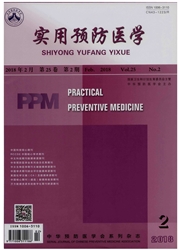

 中文摘要:
中文摘要:
目的 了解北京市职业人群应急准备现状及其影响因素,为制定干预策略提供依据。 方法 采用多阶段分层整群抽样方法,选取北京市18岁以上职业人群800人于2015年进行问卷调查, 调查内容包括基本情况、应急准备量表、应急经历与判断、应急知识与技能、能力建设相关活动参与情况等内容。运用χ2检验进行单因素分析,应用logistic 回归进行多因素分析。 结果 北京市18岁以上职业人群仅有2.6%的职业人群表示已经做好了各种应急准备行动,22.3%的人不计划采取任何准备行动。应急准备测评总体平均分(3.28±0.47)分,应急意识、应急态度、应急心理与文化、应急准备行为倾向、应急知识与技能各维度平均分分别为(2.91±0.79)、(3.45±0.67)、(3.36±0.55)、(3.09±0.88)、(3.63±0.81)分。职业人群不做应急准备的原因主要为不知道应该做什么(55.2%)。女性、卫生相关技术人员、居住房屋类型为高层有电梯人群、购买商业保险人群、接受过应急教育/培训、演练以及应急意识、应急态度、应急心理和文化、应急准备行为和应急知识与技能5个方面平均分≥4 分者应急准备率较高,分别为29.5%、45.9%、32.6%、31.3%、39.9%、40.5%、44.3%、36.7%、39.4%、43.7%和33.3%。logistic回归分析显示:购买商业保险[P=0.15,OR=1.582, 95%CI(1.092~2.292)]、接受宣传/培训[P=0.006,OR=2.348,95%CI(1.279~4.311)]、应急准备行为倾向[P=0.003,OR=2.026,95%CI(1.280~3.207)]是职业人群应急准备水平的影响因素。 结论 北京市职业人群的应急准备情况有待提高。需要加强对职业人群的应急教育/培训,培养风险意识,提高应急知识与技能水平,提升应急准备水平。
 英文摘要:
英文摘要:
Objective To investigate the current situation of emergency preparedness and its influencing factors among occupational population in Beijing City so as to provide evidence for developing intervention strategies. Methods A multi-stage stratified cluster sampling method was used to select 800 staff members aged over 18 years in Beijing City in 2015, and then we conducted a questionnaire survey on basic information, measuring scale for emergency preparedness, emergency experience and judgment, emergency knowledge and skills, and information about the involvements in ability development activities. Chi-square test was used for single factor analysis and logistic regression for multivariate analysis. Results Only 2.6% of the occupational population aged over 18 years in Beijing City got ready for emergency preparedness and 22.3% had no any emergency plan. The overall average score of emergency preparedness was (3.28±0.47). The scores of emergency awareness, emergency attitude, emergency psychology and culture, emergency preparedness behavior tendency and emergency knowledge and skills were (2.91±0.79), (3.45±0.67), (3.36±0.55), (3.09±0.88) and (3.63±0.81) respectively.The main reason for having no emergency preparedness was at a loss what to do. The staff members who were females, health-related technical personnel, lived in high-rise buildings with elevators, purchased commercial insurance, had emergency education or training and drilling, and who had the scores of emergency awareness, emergency attitude, emergency psychology and culture, emergency preparedness behavior, and emergency knowledge and skills ≥ 4 points, had a higher ratio of good preparedness for possible emergencies, which were 29.5%, 45.9%, 32.6%, 31.3%, 39.9%, 40.5%, 44.3%, 36.7%, 39.4%, 43.7% and 33.3% respectively. Logistic regression analysis showed that the factors influencing the level of emergency preparedness in the occupational population were purchasing commercial insurance (P=0.15, OR=1.582, 95%CI (1.092
 同期刊论文项目
同期刊论文项目
 同项目期刊论文
同项目期刊论文
 期刊信息
期刊信息
